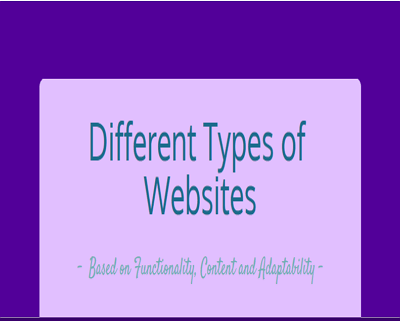Different Types of Websites in 2019
As appeared in Venngage
What are the different types of websites in 2019?
Did you know:
“There are 1,477,803,927 active websites on the World Wide Web according to Netcraft.”
And surprisingly these 1.4 billion websites can be segregated into 3 different types of websites in the current year – 2019. In addition to this, the three governing factors behind the differentiation are:
This post covers details about the above factors.
Functionality
The prime factor for segregation when we talk about different types of websites is Functionality. Moreover, when any leading website design agency inquire about client’s requirement. While some clients need awesome visuals, at the other hand some need the functionality to be perfect.
A perfect example of one such website is Amazon. Although the visuals are not very appealing, but the website’s functionality is excellent.
Hence, based on functionality, we can categorize sites into 5 different types of websites.
#1. Brochure Websites
These websites are majorly for small businesses, or start-ups website designing. Essentially, these are very simple websites in terms of functionality. Moreover, these websites are like the “Brochure” or “Flyers”. Among other different types of websites these are the most basic ones.
These only contain a home page, an about us page, a contact page and one or two more pages. An example of a brochure website is: DB Realty
Read more about: Why should every small business have a website.
#2. eComerce Websites
Such websites allows selling and buying of products or services to online users. Functionally eCommerce website development requires a trained developer for smooth operations.
Additionally, eCommerce websites are of two kinds. One where a single company can sell its products or services to multiple users. Or, it can act as a marketplace where multiple companies can sign up as vendors. And sell their respective products/services to multiple users through a single site.
A classic example of a marketplace is Amazon.com.
Read more about: E commerce Website Design FAQs
#3. Portal Websites
A portal website allows users to access multiple information like emails, forums, search engine etc from one place. Many universities, businesses etc have their private portals to ease internal communication through portals.
A classic example of a portal website is: Naukri.com
#4. Wiki Websites
As the name suggests, a wiki website allows users to come together and write content online on a website. Moreover, a wiki website needs an experienced website designer and developer to create a flawless website.
Example: Wikipedia
#5. Social Media Websites
These websites allows users to interact socially on the internet by exchanging messages, images, videos and more. One of the most common example of a social media website is Facebook.
Content
When you ask a website designing company in Delhi to create a website for you, the first question they ask is;
“Do you want your content to be dynamic or static?”
On the basis of how often you’d like to update your content, there are two types of websites.
- Static Websites
- Dynamic Website
Static Websites
Static Website Designing is done using HTML. These are very simple websites. Moreover, the content of static websites do not change. Additionally, it requires a developer if any change or addition is necessary in the website.
Example: Dr. Divya Sharma
Dynamic Websites
Dynamic Website Designing is done using HTML, CSS, JS, PHP and other technologies. It is much complicated than static websites. With these websites the content is updated or changed every time a user visits your website.
A Blog or an eCommerce website are the best example to explain a dynamic website.
Design Adaptability
This category among other different types of websites is based on design adaptability of a website. Based on the optimization of a website on different screen sizes it is classified into three sub-categories.
- Static/Fixed
- Fluid
- Responsive
Static/Fixed
Just as the name these websites are fixed in terms of width, no matter what the screen size is. Meaning, the design is not optimized for different screen sizes. Moreover, a user has to zoom in to view the content of such websites on mobile or tablets.
Hence, these websites are not recommended due to increasing mobile activity in today’s world.
Read: 5 Website designing Trends in 2019
Fluid
Just like liquids, fluid websites adapt to the screen size. However, this does not mean that they are designed specifically for different screen sizes.
For instance, the navigation menu of a fluid website is the same in design on a desktop, mobile or a tablet.
Responsive
Responsive Websites are highly optimized for all screen sizes. The user does not need to pinch or zoom to view the content of a website. It is user friendly and search engine friendly too.
Responsive website design or mobile friendly website designing is highly recommended because majority of the users are turning to mobile phones for browsing.
Conclusion
No matter what website type you choose among different types of websites, but make sure it is responsive in nature. This is important to give an awesome experience to your users. And also to rank in the organic search results.
Looking for a SEO Company in Delhi?
Contact our Digital Marketing Agency in Delhi for all your web designing and SEO requirements.
